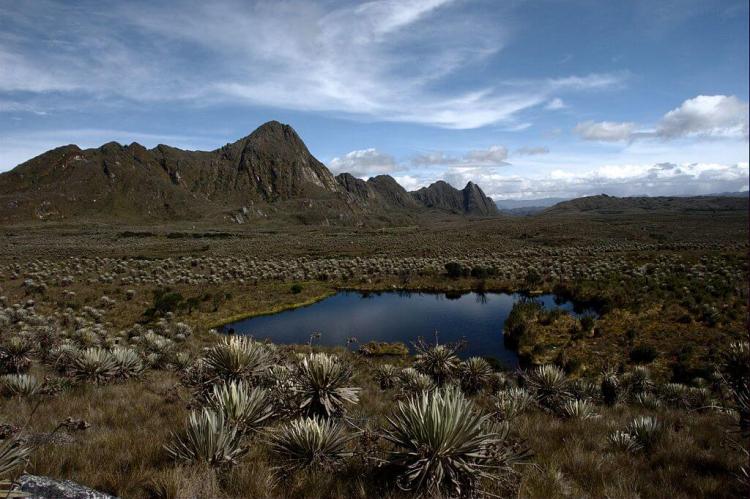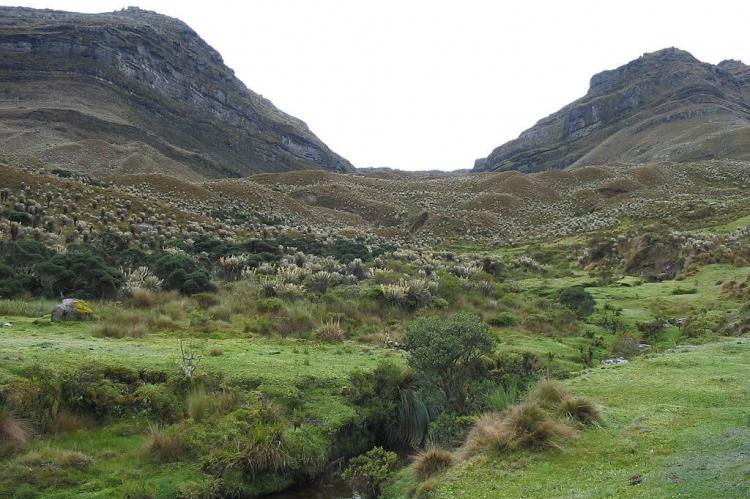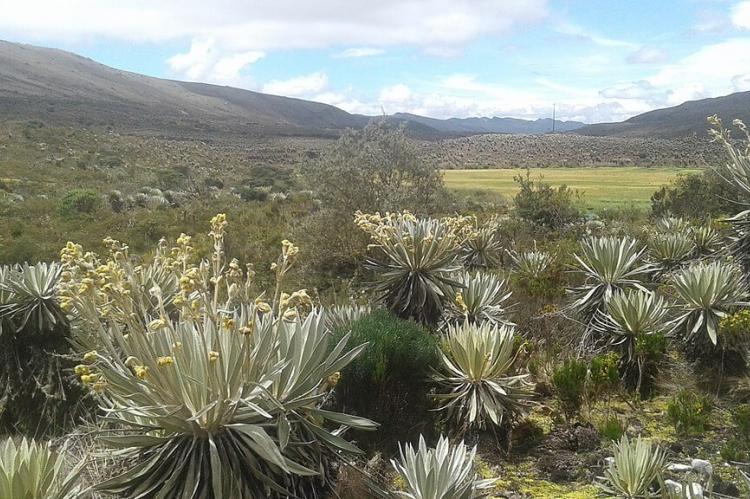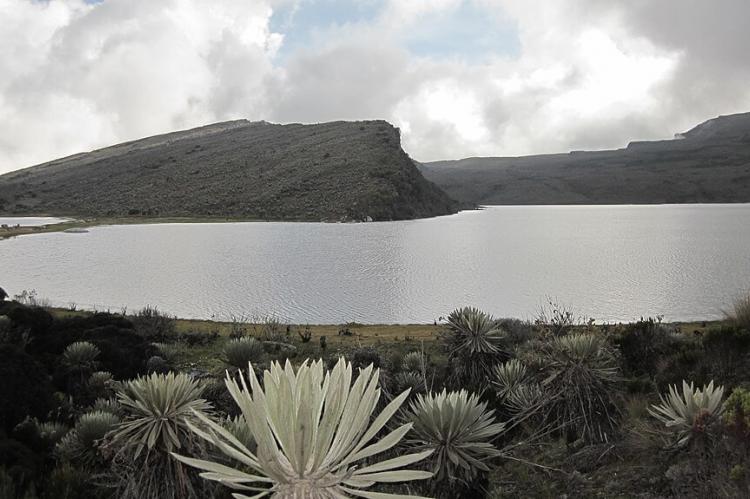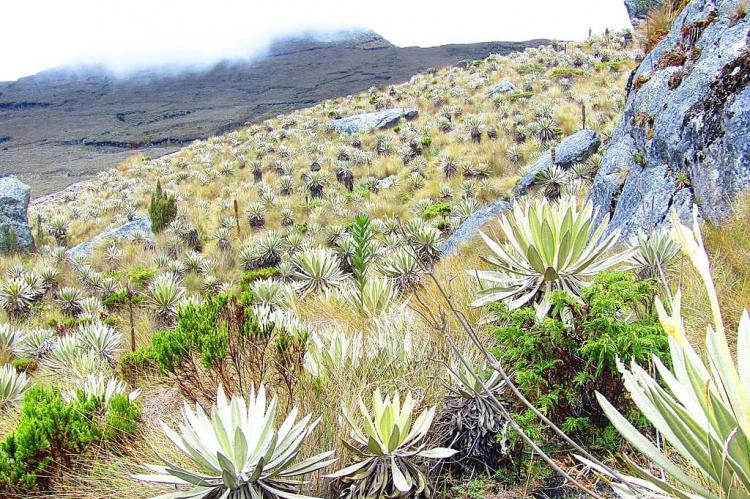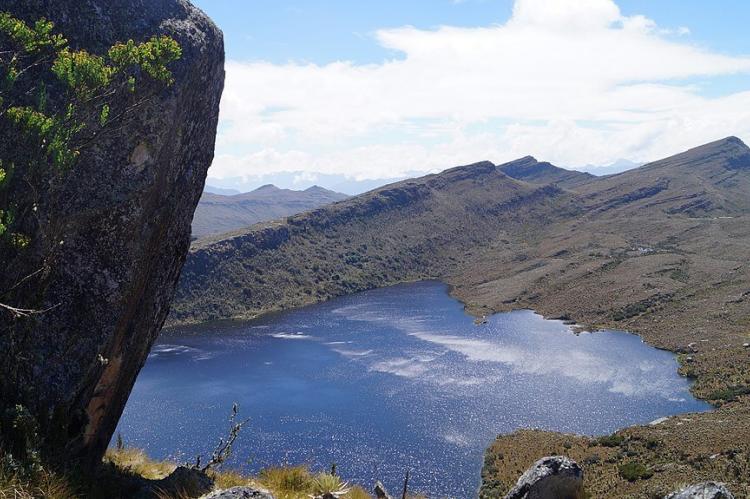The Sumapaz Páramo: Colombia's Pristine Moorland Majesty
The Sumapaz Páramo is the largest moorland ecosystem on the planet, located in the Colombian Andes. Sumapaz National Natural Park safeguards this ecologically important area and serves as a sanctuary in a pristine wilderness for countless species of flora and fauna.
The Sumapaz Páramo
Colombia's Pristine Moorland Majesty
Nestled within the rugged terrain of the Colombian Andes lies a realm of breathtaking beauty and ecological significance – the Sumapaz Páramo. Stretching across the undulating landscapes of the Altiplano Cundibohyacense mountain range within the Cordillera Oriental, this extraordinary biome captures the imagination with its vast expanses of high mountain grasslands.
As the largest moorland ecosystem in the world, the Sumapaz Páramo unveils a landscape of unparalleled grandeur and biodiversity, where rugged peaks pierce the sky, and rolling hills are adorned with a tapestry of vibrant hues. Here, amidst the pristine wilderness, lies a sanctuary for countless species of flora and fauna, each intricately woven into the fabric of this ecological masterpiece.
From the gentle sway of native grasses to the majestic presence of towering frailejones, the Sumapaz Páramo is a testament to the resilience and splendor of nature's design. Recognizing its irreplaceable value, the Sumapaz Páramo has been enshrined as a National Natural Park, a testament to Colombia's commitment to preserving its natural heritage for generations.
Cultural Heritage
Dating back to antiquity, the Sumapaz Páramo has been a sacred sanctuary for indigenous communities, particularly the Muisca civilization, which thrived in the region between 600 and 1600 CE. For the Muisca people, the land was more than mere terrain; it was a living embodiment of their spiritual beliefs and cultural identity. Revered for its natural bounty and mystical allure, the Sumapaz Páramo held a central place in Muisca cosmology. It served as a sacred space where rituals were performed, ceremonies conducted, and connections forged with the divine.
The landscape of the Sumapaz Páramo resonates with echoes of ancient civilizations, as evidenced by archaeological remnants dating back to 1500 B.C.E. These artifacts, ranging from ceremonial sites to stone tools, offer poignant glimpses into the lives and customs of the indigenous peoples who once called this land home. From the enigmatic petroglyphs etched into rocky outcrops to the sacred springs revered as life-giving water sources, every facet of the Sumapaz Páramo bears testimony to the profound bond between humans and their natural environment.
Ecological Importance and Water Source
The ecological significance of the Sumapaz Páramo transcends its cultural heritage, as it stands as a vital cornerstone of Colombia's ecosystem and water security. Positioned strategically between the Orinoco and Magdalena river basins, this expansive moorland ecosystem plays a pivotal role in regulating the flow and quality of water throughout the region.
At the heart of its ecological importance lies its role as a primary water source for Colombia's densely populated Bogotá savanna. The pristine waters from the Sumapaz Páramo serve as a lifeline for millions of Colombians, providing essential freshwater resources for agriculture, drinking water, and industrial activities. The Bogotá savanna, with its sprawling urban centers and fertile agricultural lands, relies heavily on the sustained flow of water from the Sumapaz Páramo to meet the diverse needs of its inhabitants.
Furthermore, the Sumapaz Páramo acts as a natural filtration system, purifying and enriching the water that flows through its pristine landscapes. The dense vegetation, including endemic plant species such as the towering frailejones, helps capture sediment and pollutants, ensuring the water remains clean and clear as it journeys downstream. This natural filtration process benefits the ecosystems within the Sumapaz Páramo and contributes to the overall health of Colombia's waterways and aquatic habitats.
Moreover, as one of the largest water reserves in Colombia, the Sumapaz Páramo plays a crucial role in maintaining the nation's ecological resilience in the face of environmental challenges. Its vast expanse of high-altitude grasslands is a buffer against climate variability, helping regulate temperature and precipitation patterns across the region. By preserving the integrity of the Sumapaz Páramo, Colombia can safeguard its water resources and ensure the sustainability of its ecosystems for future generations.
Environmental Conditions and Adaptations
The Sumapaz Páramo is a testament to the resilience and adaptability of life in the face of harsh environmental conditions. Situated at elevations ranging from 3,500 to 4,000 meters (11,500 to 13,000 feet) above sea level, this pristine landscape experiences the extreme climatic conditions characteristic of alpine tundra environments. Temperatures fluctuate dramatically between -10 °C and 17 °C (14 °F to 62.6 °F), subjecting the region to frigid cold and occasional warmth. Coupled with high humidity and frequent precipitation, the Sumapaz Páramo presents a challenging habitat for flora and fauna.
Despite these inhospitable conditions, the flora and fauna of the Sumapaz Páramo have evolved remarkable adaptations to thrive in this unique environment. The vegetation of the Páramo is characterized by its hardiness and resilience, with species such as the iconic frailejones (Espeletia) dominating the landscape. These towering plants have evolved specialized adaptations to survive in the harsh alpine climate, including thick, woolly stems and leaves that help insulate against freezing temperatures and retain moisture. Additionally, Sphagnum moss, which covers vast expanses of the Páramo, enhances the soil's capacity to hold water and nutrients, providing essential support for plant life.
In addition to its unique plant life, the Sumapaz Páramo is home to a diverse array of fauna that has adapted to its challenging environmental conditions. Species such as the endangered Spectacled Bear, Little Red Brocket Deer, and Páramo duck have evolved specialized behaviors and physical traits to thrive in this high-altitude ecosystem. From thick fur coats that provide insulation against the cold to efficient foraging strategies that maximize energy intake, these animals exemplify nature's ingenuity in the face of adversity.
Furthermore, the presence of shallow bodies of water known as "Chupaderos" or "Chucuas" adds to the dynamic nature of the Sumapaz Páramo. These temporary pools serve as vital sources of moisture for both plant and animal life, providing essential hydration in an otherwise arid landscape. They also serve as breeding grounds for aquatic species, further enriching the biodiversity of the Páramo.
Sumapaz National Natural Park
Sumapaz National Natural Park is a bastion of biodiversity, safeguarding approximately 178,000 hectares (440,00 acres) of pristine moorland habitat within its protected boundaries. Established in 1977, this sanctuary ensures the preservation of the Sumapaz Páramo's rich flora and fauna diversity, serving as a beacon of conservation in Colombia's natural landscape.
At the heart of Sumapaz National Natural Park lies its remarkable array of vascular plants, comprising over 200 species that have adapted to thrive in the challenging conditions of the Páramo. Many of these plant species exhibit high levels of endemism, meaning they are found nowhere else on Earth. Among the most iconic inhabitants are the Espeletia, towering giants known as "frailejones," which dominate the landscape with their otherworldly presence. With their rosettes of silvery leaves and towering stems, these majestic plants have become emblematic of the Sumapaz Páramo, symbolizing the resilience and beauty of this unique ecosystem.
In addition to the frailejones, Sumapaz National Natural Park is also home to a diverse array of tree species, including the encenillo tree and various species of tibouchina. These trees contribute to the park's ecological diversity, particularly in canyon areas where they form lush forests that provide habitat for many wildlife species. The encenillo tree, in particular, plays a vital role in stabilizing the soil and preventing erosion, while tibouchina species add splashes of color to the landscape with their vibrant blooms.
Moreover, Sphagnum moss carpets vast expanses of the Sumapaz Páramo, enveloping the landscape in a verdant cloak that enhances soil moisture retention and nutrient cycling. With its sponge-like structure, this moss acts as a reservoir for water, storing and releasing moisture as needed to support the surrounding plant life. In addition, Sphagnum moss plays a crucial role in carbon sequestration, helping mitigate the impacts of climate change by trapping carbon dioxide from the atmosphere.
The rich flora diversity of Sumapaz National Natural Park provides the foundation for a thriving ecosystem, supporting many fauna species that depend on these plants for food, shelter, and habitat. From elusive mammals such as the Spectacled Bear and Little Red Brocket Deer to avian species like the golden eagle and Páramo duck, the park teems with life, each species intricately woven into the fabric of the Páramo's ecological web.
Fauna within Sumapaz
The fauna of Sumapaz is a vibrant tapestry of biodiversity, encompassing a diverse array of species that have adapted to thrive in the challenging high-altitude environment of the Páramo. Among the notable inhabitants are several endangered and endemic species, each playing a crucial role in the park's ecological web and contributing to its resilience and balance.
One of the most iconic and charismatic species found within Sumapaz is the Spectacled Bear (Tremarctos ornatus), the only bear species native to South America. These elusive creatures, named for the distinctive markings around their eyes, roam the rugged terrain of the Páramo in search of food, shelter, and mates. As apex predators, Spectacled Bears are vital in regulating prey species' populations and shaping the ecosystem's dynamics.
Another emblematic species in Sumapaz is the Little Red Brocket Deer (Mazama rufina), a small and elusive deer species inhabiting the dense forests and grasslands of the Páramo. Endemic to the Andean region, these deer are highly adapted to their mountainous habitat and play a crucial role in seed dispersal and vegetation dynamics.
The tapir (Tapirus spp.) is another flagship Sumapaz species revered for its unique appearance and ecological importance. These large, herbivorous mammals play a crucial role in maintaining the health of the forest ecosystem through seed dispersal and habitat modification. Despite threats from habitat loss and hunting, tapir populations within Sumapaz are protected by conservation efforts to safeguard their habitats and reduce human-wildlife conflict.
Other notable inhabitants of Sumapaz include the coati (Nasua spp.), a member of the raccoon family known for its agile climbing abilities and omnivorous diet, and the golden eagle (Aquila chrysaetos), a majestic bird of prey that soars above the Páramo in search of prey.
One of the most elusive and enigmatic species found within Sumapaz is the Páramo duck (Anas flavirostris). Endemic to the high-altitude wetlands of the Andes, these ducks are highly adapted to their cold and inhospitable habitat, with specialized adaptations such as thick down feathers and webbed feet that enable them to navigate the shallow waters of the Páramo.
Conservation Efforts
Conservation efforts within Sumapaz National Natural Park aim to safeguard these precious species and their habitats, ensuring their survival for future generations to cherish and study. Through habitat restoration, anti-poaching patrols, and community engagement initiatives, park authorities work tirelessly to protect the biodiversity of Sumapaz and promote sustainable coexistence between humans and wildlife.
In conclusion, the Sumapaz Páramo is a testament to the awe-inspiring beauty and ecological significance of Colombia's natural heritage. From its geological origins and cultural legacy to its vital role as a water source and biodiversity hotspot, Sumapaz encapsulates the intricate interplay between human society and the natural world.
